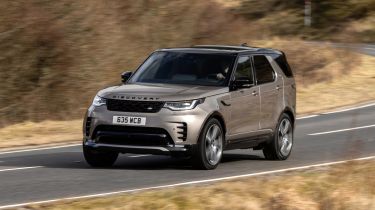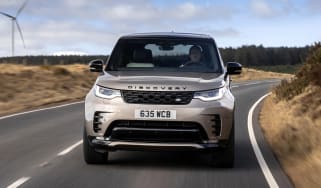Land Rover Discovery review - MPG, running costs & CO2
"The Discovery is far from the most economical option, with no plug-in hybrid model and high CO2 emissions"
When a car is first released, manufacturers tend to highlight any significant weight loss over the outgoing model, with a circa-100kg reduction usually being deemed noteworthy. That puts the latest Land Rover Discovery’s diet into context, as it’s 450kg lighter than the car it replaced. Economy is the net beneficiary here, as the less mass an engine has to shift, the less fuel it uses.
The Discovery was fitted with mild-hybrid tech in 2021, and now there’s just one diesel engine left: the D350 V6. Petrol engines have been removed entirely, but those are hardly missed from a fuel-efficiency standpoint, because they could only achieve up to a measly 25mpg.
While the mild-hybrid assistance does come at a small benefit to efficiency, in the face of more sophisticated plug-in rivals the Discovery still feels something of a dinosaur. For instance, rivals such as the Volvo XC90 Recharge can travel up to 40 miles on electric power alone. Land Rover has explored the possibility of a PHEV Discovery, but claimed that it would have to ditch the third-row seats to accommodate a hybrid battery and motor.
Land Rover Discovery MPG & CO2
The previous Land Rover Discovery was built using a ‘ladder frame’ construction, so its bodywork was essentially bolted onto the car underneath. The latest Discovery, on the other hand, comprises a modern aluminium monocoque, meaning the bodywork is structural. You don’t need to know this as an owner, but it goes some way to explaining how the latest Discovery manages to be 15% more fuel-efficient than the last one – although it’s still not quite as frugal as the BMW X5, Audi Q7 or Volvo XC90.
More reviews
The sole engine available at the time of writing is the D350 mild-hybrid diesel, which gets an official fuel-efficiency figure of up to 34.8mpg. That’s not bad for a diesel in a car of its size, but with rivals offering ever-more hi-tech solutions to boost fuel economy, it’s hardly impressive in the grander scheme of things. High CO2 emissions of 213g/km also mean it’s unlikely to be a wise choice as a company car because it will sit in a high Benefit-in-Kind (BiK) group.
Because the range starts at over £40,000, all Discoveries incur a VED (tax) surcharge in years two to six. After that period is up (at which point the car could well be with its second owner), road tax drops to the standard rate.
Insurance
The Discovery is classified in insurance groups 33-44 out of 50, so premiums will be reasonably pricey – though in fairness, the least powerful BMW X5 and Audi Q7 attract higher rankings. If you’re really after a Discovery, you could use any savings you’ll net from insurance premiums to offset the company-car tax bills.
Warranty
The three-year/unlimited-mileage warranty Land Rover provides with the Discovery is reasonable, if unexceptional. It certainly falls short of the seven-year warranty provided as standard with the seven-seat Kia Sorento, or the Toyota Land Cruiser's cover, which can last up to 10 years so long as it's serviced by Toyota.
Servicing
It’s worth noting the Discovery’s diesel engines use a fluid called AdBlue to help keep emissions down. High-mileage users may find they need to top up with AdBlue between services; Land Rover will do this for around £30. A service plan may also be worth investigating, something which your dealer can arrange based on your circumstances.













